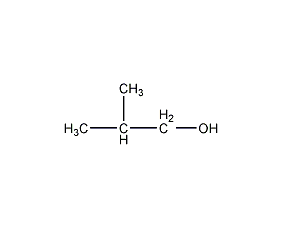Isobutyl alcohol Isobutyl alcohol


Structural formula
| Business number | 01NP |
|---|---|
| Molecular formula | C4H10O |
| Molecular weight | 74 |
| label |
2-Methyl-1-propanol, isopropylmethanol, fermented butanol, 1-Hydroxymethylpropane, 2-Methylpropanol, 1-Hydroxymethylpropane, Fermentation butyl alcohol, Aliphatic alcohols, ethers and their derivatives |
Numbering system
CAS number:78-83-1
MDL number:MFCD00004740
EINECS number:201-148-0
RTECS number:NP9625000
BRN number:1730878
PubChem number:24881090
Physical property data
1. Properties: colorless and transparent liquid with a slight smell of amyl alcohol. [1]
2. Melting point (℃): -108[2]
3. Boiling point (℃): 107.9[3]
4. Relative density (water=1): 0.81 (15℃)[4]
5. Relative vapor density (air = 1): 2.55[5]
6. Saturated vapor pressure (kPa): 1.17 (20℃)[6]
7. Heat of combustion (kJ/mol): -2667.7[7]
8. Critical temperature (℃): 274.6[8]
9. Critical pressure (MPa): 4.3[9]
10. Octanol/water partition coefficient: 0.76[10]
11. Flash point (℃): 28 (CC); 37.7 (OC) [11]
12. Ignition temperature (℃): 415[12]
13. Explosion upper limit (%): 10.9[13]
14. Lower explosion limit (%): 1.2[14]
15. Solubility: soluble in water, easily soluble in ethanol and ether. [15]
16. Heat of formation (KJ/mol): -339.4
17. Heat of fusion (KJ/kg): 125.2
18. Specific heat capacity (KJ/(kg·K), constant pressure): 2.39
19. Boiling point rising constant: 2.01
20. Electrical conductivity (S/m ): 8×10-8
21. Thermal conductivity (W/(m·K), 0ºC): 15.49
22. Volume expansion Coefficient (K-1, 20ºC): 0.00095
23. Critical density (g·cm-3): 0.271
24. Critical volume (cm3·mol-1): 274
25. Critical compression factor: 0.258
26. Eccentricity factor: 0.589
27. Lennard-Jones parameter (A): 13.73
28. Lennard-Jones parameter (K): 158.5
29 .Solubility parameter (J·cm-3)0.5: 23.751
30. van der Waals area (cm2·mol-1): 7.620×109
31. van der Waals volume (cm3·mol -1): 52.390
32. Gas phase standard combustion heat (enthalpy) (kJ·mol-1): 2720.10
33. Gas phase standard claimed heat (enthalpy) (kJ·mol-1): -283.09
34. Phase standard combustion heat (enthalpy) (kJ·mol -1): -2669.27
35. Liquid phase standard claims heat (enthalpy) (kJ·mol-1): -333.93
36. Liquid phase standard entropy (J·mol-1·K-1): 214.5
37. Liquid phase standard free energy of formation ( kJ·mol-1�
Purpose
1. Used as a co-solvent for nitrocellulose, a solvent for ethyl cellulose, polyvinyl butyral, various oils, rubber, and natural resins. Organic synthetic raw materials. Can be used to make petroleum additives, antioxidants, 2,6-di-tert-butyl-p-cresol, isobutyl acetate (paint solvent), plasticizers, synthetic rubber, artificial musk, fruit essential oils, esters and synthetic drugs wait. It can also be used to purify salt chemical reagents such as strontium, barium and lithium and as a high-grade solvent. The scope of application is limited and must not be used to make agricultural plastics because isobutanol can cause crop death.
2. Reagents for the determination of calcium, strontium, barium, sodium, potassium, lithium, silver, chlorine and phosphite. Chromatographic analysis of reference materials. It is also a commonly used solvent and extraction agent. Used to extract lithium chloride from a mixture of lithium chloride and sodium chloride or potassium chloride. Used in the manufacture of petroleum additives, antioxidants, 2,6-di-tert-butyl-p-cresol, isobutyl acetate (paint solvent), plasticizers, synthetic rubber, artificial musk; fruit essential oils and synthetic drugs, etc.
3. Basic organic chemical raw materials, used as diluents for adhesives and solvents for ethyl cellulose, polyvinyl butyral, rubber, natural resins and various oils. It is also used as a raw material for petroleum additives, antioxidants, plasticizers, synthetic rubber, artificial musk, fruit essential oils, esters and synthetic drugs. It can also be used to purify strontium, barium, lithium and other salt chemical reagents. At present, domestic isobutanol is mainly used to produce diisobutyl phthalate plasticizer and isobutyl acetate solvent, and a small amount is used to produce isobutyl butyrate, isobutyl lactate, etc.
4. Mainly used as solvent and in organic synthesis. [26]
